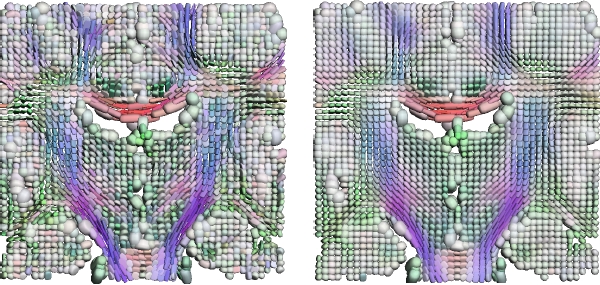Difference between revisions of "Projects:DiffusionTensorImageFiltering"
| Line 2: | Line 2: | ||
Back to [[NA-MIC_Collaborations|NA-MIC_Collaborations]], [[Algorithm:Utah|Utah Algorithms]] | Back to [[NA-MIC_Collaborations|NA-MIC_Collaborations]], [[Algorithm:Utah|Utah Algorithms]] | ||
| + | |||
| + | <div class="thumb tright"><div style="width: 602px">[[Image:DTIFiltering.jpg|[[Image:DTIFiltering.jpg|Coronal slice from a noisy diffusion tensor image (left). The same slice after applying our DTI filtering method (right).]]]]<div class="thumbcaption"><div class="magnify" style="float: right">[[Image:DTIFiltering.jpg|[[Image:magnify-clip.png|Enlarge]]]]</div>Coronal slice from a noisy diffusion tensor image (left). The same slice after applying our DTI filtering method (right).</div></div></div> | ||
'''Objectives''' | '''Objectives''' | ||
| Line 10: | Line 12: | ||
We have implemented several filtering methods for DT-MRI, including our new method and also several methods from the literature. One goal is to determine whether it is best to filter the estimated tensor fields or the original diffusion weighted images. The method that we developed filters the original diffusion weighted images and takes into account the physical properties of the imaging noise. We are comparing this method with others in the literature, including methods that filter the estimated tensor fields. Our preliminary findings are that it is advantageous to filter the DWIs and to include a physical model of the noise. | We have implemented several filtering methods for DT-MRI, including our new method and also several methods from the literature. One goal is to determine whether it is best to filter the estimated tensor fields or the original diffusion weighted images. The method that we developed filters the original diffusion weighted images and takes into account the physical properties of the imaging noise. We are comparing this method with others in the literature, including methods that filter the estimated tensor fields. Our preliminary findings are that it is advantageous to filter the DWIs and to include a physical model of the noise. | ||
| − | |||
| − | |||
| − | |||
| − | |||
''References'' | ''References'' | ||
Revision as of 14:13, 4 September 2007
Home < Projects:DiffusionTensorImageFilteringDiffusion Tenson Image Filtering
Back to NA-MIC_Collaborations, Utah Algorithms
Objectives
We are developing new denoising methods for diffusion tensor MRI. These methods are based on physical noise models in DT-MRI.
Progress
We have implemented several filtering methods for DT-MRI, including our new method and also several methods from the literature. One goal is to determine whether it is best to filter the estimated tensor fields or the original diffusion weighted images. The method that we developed filters the original diffusion weighted images and takes into account the physical properties of the imaging noise. We are comparing this method with others in the literature, including methods that filter the estimated tensor fields. Our preliminary findings are that it is advantageous to filter the DWIs and to include a physical model of the noise.
References
Key Investigators
- Utah: Saurav Basu, Tom Fletcher, Ross Whitaker
- BWH: Sylvain Bouix, Doug Markant, Adam Cohen, Marc Niethammer, Marek Kubicki, Mark Dreusicke, Martha Shenton
Links
Project Week Results: Jan 2006
